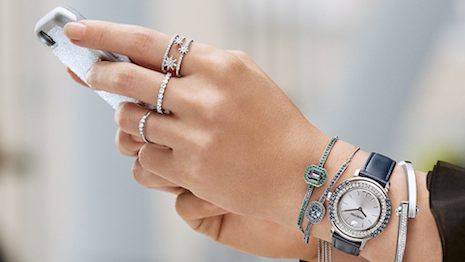- About
- Subscribe Now
- New York,
June 5, 2017

 Mobile is now vital, image courtesy of Swarovski
Mobile is now vital, image courtesy of Swarovski
Despite luxury brands being notoriously slow to adopt mobile technology, a new report from ContentSquare found that 73 percent of luxury buyers browse via the small screen.
Luxury marketers who do not have an optimal mobile experience are missing out on a huge opportunity, according to ContentSquare. Affluent consumers that purchase luxury products take less time looking at each product online compared to the standard buyer and make up their purchasing decisions via emotion.
“Luxury visitors are more likely to convert on the first visit than ecommerce users,” said Efrat Ravid, chief marketing and strategy officer of ContentSquare. “We could even cautiously say that luxury users are ‘compulsive’ buyers.
“They spend an average of 30 seconds on each product description — half the average time spent by ecommerce users,” he said. “However, these sessions are more fruitful, with twice as many visitors actively window-shopping, viewing six or more products per session.”
ContentSquare looked at more than 125 million user sessions between November 2016 and February 2017.
Luxury versus ecommerce
The research notes that mobile users in fact do interact with the same amount of information as those on desktop, but just much faster.
All marketers need to keep in mind that sessions on mobile devices are extremely short. Thirty-seven percent of all mobile sessions last less than a minute.
Graph from ContentSquare
Luxury brands are on the hook to create special experiences in everything they do, including their online experiences. Consumers expect a unique experience when shopping with more expensive brands in all aspects of the retail experience.
Users on luxury Web sites who view more than six products during their first visit make up more than 37 percent of all luxury visitors. Only 5 percent of the average ecommerce user will view more than six products.
Graph from ContentSquare
Average ecommerce users spend 60 seconds engaging with product descriptions. But luxury buyers spend half that time at 30 seconds on each product description.
Additional insight
Another report from Leanplum suggests that the simple addition of mobile-native emojis to push notifications can lift engagement more than even illustrations.
The report took a look at how brands can boost the engagement on their social marketing, particularly when it comes to mobile. With app revenues rising and more and more consumers engaging with brands on mobile, it is imperative for brands to be able to wring the most amount of use out of every campaign (see more).
Another major point for luxury brands is social media. Plus-sized model and social media influencer Iskra lead the way for the top content coming out on Instagram from New York Fashion Week, as influencer content saw the most engagement well beyond designer content, according to Chute.
Michael Kors and Vogue were the luxury brands amongst the top content creators who saw the most engagement surrounding NYFW. Fashion Blogger was the top hashtag discussed in relation to Fashion Week, alluding to the rise of importance of fashion blogger Instagram influencers for NYFW (see more).
“Seventy-three percent of luxury visitors are browsing via mobile, 65 percent smart phones, 8 percent tablet,” ContentSquare's Mr. Ravid said. “This is a huge percentage. Brands must therefore make sure that the mobile experience they offer is outstanding, without delays in loading time, displaying data that is easy to scroll and consume.
“Mobile visitors consume as much information as desktop users, but they do it much faster,” he said. “Eighty percent of homepages visited by the ecommerce customers we studied share a similar format in terms of layout and structure.
“However, people expect special and unique experiences from luxury brands. Just as the physical luxury store provides a very unique branded experience, so must the digital experience. It should be unique and convey the brand in the same way that the physical stores do.”
Share your thoughts. Click here